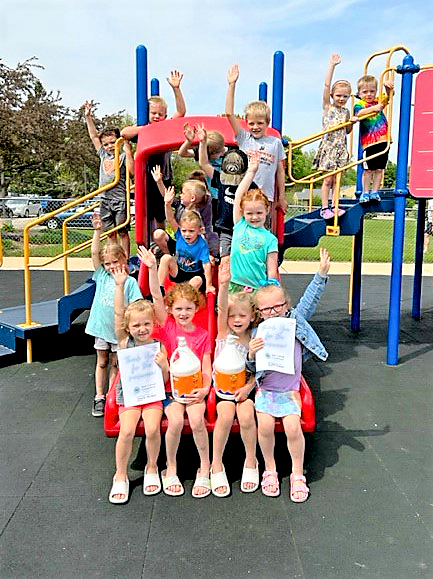Sun-Safety Community Project

Osceola Community Health Services helps bright Beginnings enrollees and staff members stay sun safe this summer!
The Iowa Cancer Consortium, in partnership with the Iowa Department of Health and Human Services, will distribute over 80 gallons of sunscreen through its Sun-Safety Community Project this summer. As a 2023 awardee, Osceola Community Health Services received 2 gallons of sunscreen for children and staff to use during summer events and outdoor play at bright Beginnings Daycare Center.
As the weather gets warmer, more people will be spending much-needed time outdoors. While having fun in the sun, it is essential for people to protect their skin from too much exposure to ultraviolet (UV) light. Invisible UV rays from the sun, tanning beds, and sunlamps can damage skin cells and cause skin cancer. Tanning is neither safe nor healthy since it’s actually a sign of injury to the skin.
Skin cancer is the most common cancer in the United States, with approximately 9,500 people diagnosed with it every day according to the American Academy of Dermatology. The main types of skin cancer are squamous cell carcinoma, basal cell carcinoma, and melanoma, each named for the different types of skin cells they affect. Melanoma is the deadliest type of skin cancer because it often spreads to other parts of the body. According to the Iowa Cancer Registry, Iowa ranks fifth in the country for its increasing melanoma rates. An estimated 1,300 Iowans will be diagnosed with skin melanoma in 2023.
The most common sign of skin cancer is a change in your skin. Regular skin checks at home can help you recognize any changes in mole and skin growth shape, size, and color. If these characteristics change over the course of a few weeks or months, it is a good idea to get them checked by a doctor. The ABCDEs of melanoma—asymmetry, border, color, diameter, and evolution—are one way to recall the signs of skin cancer.
Skin cancer can affect people of all skin colors. The most common type of melanoma in people of color develops under the nails, in the palms of hands, on the soles of feet, or in the mouth. It is good practice to keep an eye on areas of the body that don’t get a lot of sunshine, too. Also, more sunburns during childhood can increase the odds of developing melanoma later in life. So, everyone, regardless of age or skin tone, should protect themselves in the sun. To do this, a good rule to remember is the Five S’s of sun safety:
- SLIP on lightweight, light-colored clothing that covers your arms and legs
- SLOP on sunscreen with an SPF (sun protective factor) of at least 30, reapplying every 2 hours (don’t forget your SPF lip balm too!)
- SLAP on a tightly woven hat with a wide brim to cover your face, head, ears, and neck
- SEEK shade or shelter, especially during peak sun hours, usually 10 AM to 4 PM
- SLIDE on UV-blocking sunglasses to protect your eyes and the sensitive skin around them
Osceola Community Health Services is excited to educate the children and staff of bright Beginnings about the risks of UV exposure and ways they can stay safe this summer. By “slopping” on sunscreen from one of our gallons or “sliding” on a favorite pair of sunglasses, you are doing your part to reduce your risk of sun damage and skin cancer.
